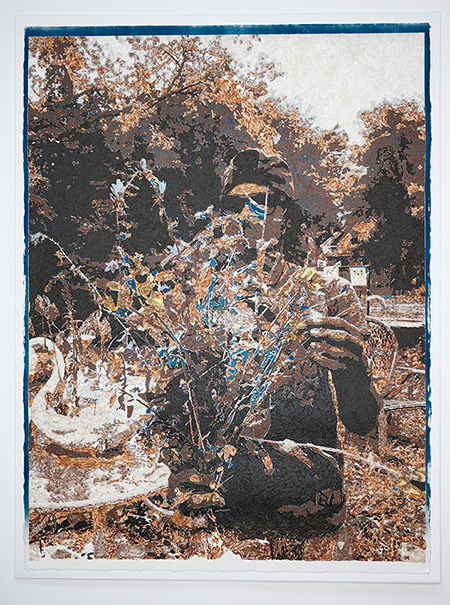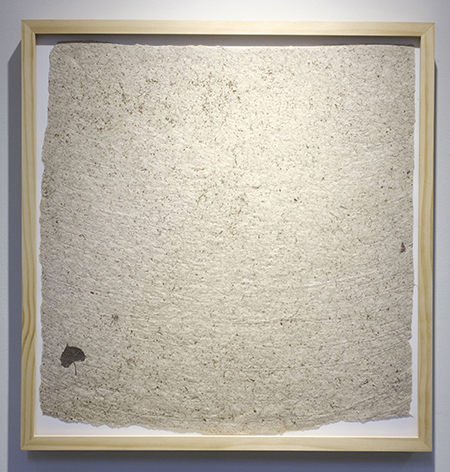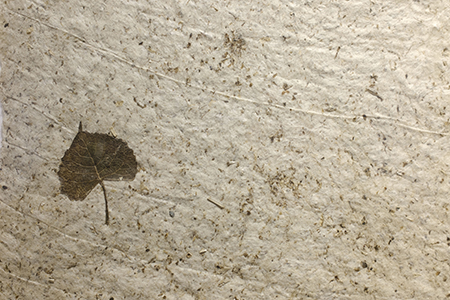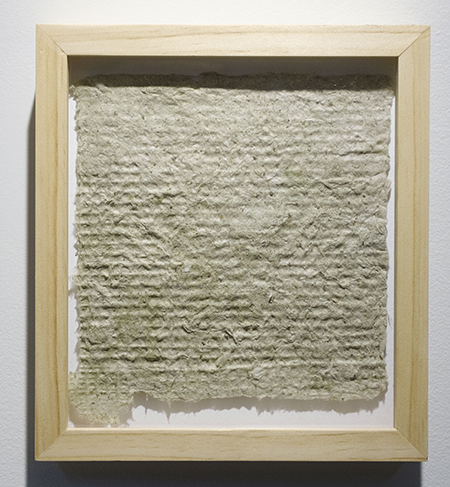Current Exhibit
Contact
Smail GalleryOlin-Rice Science Center, First Floor
Energy of the Sun
by Stephanie A. Lindquist




A Note from the Artist
This particular handmade paper from Eastern Cottonwood seeds would not exist without me having journeyed down the Mississippi River as part of the River Semester in fall 2023. For 7 weeks I joined a friendly crew of mostly Midwest college students, professors, and guests to sail down the great river out to the Gulf of Mexico. Armed with our unique interests, every day was an opportunity to learn from each other, the water, the batture (land between the river and the levees), the activists, artists, educators, and naturalists that we met along the way.
Falling evermore deeply in love with plants, I spent time wandering the batture greeting and attempting to identify plants I had never met before. Among them was Fragrant Flatsedge (Cyperus odoratus), which I read had once been used to make paper. Not knowing what to make, I felt inspired to try making handmade paper. After a few days of blending, chopping, soaking, then pouring the sedge onto my mosquito head net on the river’s beach, I accepted that I was not going to be able to break down the plant’s cellulose into a pulp.
Luckily one night when returning to my tent I noticed a pulpy mash of Cottonwood seeds buried under the leaves. Over the weeks students helped me clean the hairs by removing much of the seeds’ husks. Retted from sparse rain over 5 months, the seeds’ soft fibers were easy to blend and pour then eventually pull my first sheet of soft handmade paper.
The first industry that we sailed past when entering Louisiana’s Chemical Corridor on the Mississippi River, manufactures bleached kraft pulp for tissue and paper–perhaps even the toilet paper we so preciously carried. In contrast to this industrial scale, my gesture of very slowly crafting paper without discharging pollutants into the water and ground reconnected me to this seemingly mundane material that I often take for granted.
Back in the Twin Cities the following summer I harvested bags of Cottonwood seeds from North Mississippi Regional Park. I felt unsure how much to clean the seeds’ hair. I soon learned that the less I cleaned them and the more that I incorporated all parts of the seeds in the grinding process, the crispier and less fabric like the speckled paper became.
I would be remiss not to acknowledge the sacred qualities of waǧačaŋ (to take off the wood), čaŋ wakáŋ (name used at Sundance), čaŋyaȟu (medicinal name) known to the Dakota people since before time. The Cottonwood holds a star (which one can see in the pith) and connects the people on earth to the stars, thunder, and spiritual world. The Dakota have also known that the Cottonwood attracts/finds water and sends their roots to other sick trees in need. The inner bark may be used as food and medicine for humans and horses. And the buds are praised for their decongesting and pain relieving resin–also used by bees to make propolis in their hives.
My deepest thanks to Joe Underhill, John Kim, Kirisitina Sailiata, Roopali Phadke, Tia-Simone Gardner, Jeremy Meckler, Alicia Johnson, and Macalester and River Semester 2023 students who enriched and supported my development and work over this time. I’d also like to extend my thanks to Katie Hochman for harvesting with me and to Wakan Tipi and Jim Red Eagle for providing information online about Eastern Cottonwood and this sacred tree’s many gifts.
With gratitude,
Stephanie A. Lindquist
About the Artist
Originally from Los Angeles, Stephanie A. Lindquist transplanted here by way of New York. As Macalester’s first Artist-in-Residence (2022-2024) she collaborated with activists, educators, students, and community members around the Mississippi River. Outputs included providing free saunas co-hosted by youth in the community, creating herbal first aid kits/gifts inspired by Erica Fargione’s classes at Minneapolis Community and Technical College, organizing free plant medicine workshops in a northside garden led by local herbalists, sailing with college students down the Mississippi River to the Gulf, making paper from Cottonwood seeds, and completing a series of paintings made from soil from Sierra Leone. She looks forward to doing the work of being an Artist-in-Residence at North Mississippi River Regional Park as part of Forecast’s pilot program for the next year. To see more of her work, visit stephaniealindquist.com.